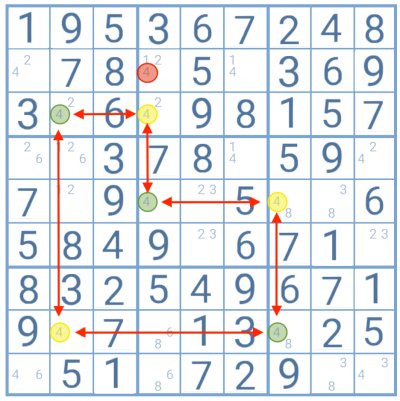
They can see cells with three, but we’ll attempt to create a chain that removes one. However, they each have the number one and can see the number one in another cell (the purple arrows point to it.) The light green squares represent the pincers in the preceding example. To accomplish so, though, you must first build a chain between the two pincers. If both pincers can view cells with the common number, you may be able to delete the shared number from those cells. In the example below, our pincers are bright green, and they both have the same candidates. Look for two bi-value cells (we’ll call them “pincers”) that can’t see each other but have at least one number in common (we’ll name it the “shared number”) to employ XY-Chain. Candidate 4 in E9 may be removed since it sees both Cells. So the answer must be in one of these Cells. In the example, depending on which way the chain is read, candidate 4 is the termination point of a Strong Link in either E1 or A9. Indeed, irrespective of how the chain is read, such a Cell “sees” a candidate that is the start of a Strong Link and a candidate that is the end of another Strong Link.īecause the candidate at the end of a Strong Link has to be the answer for that cell, it cannot be the solution for any other cell that “sees” it. If we can establish a chain that is not a loop and that begins and ends on the same contender, then any Cell that “observes” (a Cell “observes” a different Cell if both Cells relate directly to the same region) both ends of the chain cannot have that candidate as its response. The chain always begins with a Strong Link, and it always ends with a Strong Link. In the XY-CHAIN technique, we establish strong links inside “Bi-Value” Cells and Weak Links between these “Bi-Value” Cells. The following example displays an XY chain that results in elimination. The only limitation (besides the obvious needs for the links) is that the XY-Chain begins and finishes with a strong connection on the same number.Īs with X-Chains, this establishes that one of the endpoints must have that candidate put, and it may be excluded from all cells that view both ends of the chain.īecause the chain is exclusively composed of bivalue cells, the connection between the two candidates in each cell results in strong inference, allowing us to employ weak inference between the cells.Īn XY-Wing with just three cells has the shortest XY-Chain.Īn XY-Chain is a Double Implication Chain and an Alternating Inference Chain. They come in five levels of difficulty.The XY-Chain approach enables you to remove candidates similar to Y-Wing.Īn XY-Chain is a chain of cells that each contain just 2 candidates.Īn XY-Chain employs just bivalve cells (similar to Remote Pairs), but the cells might contain arbitrary candidates.
Sudoku strategy free#
For more difficult puzzles see my collection of printable free sudoku puzzles. You will be able to solve the puzzle quickly now.Ĭongratulations on solving a very difficult Sudoku puzzle. Solve the naked single and the logjam is broken. When you remove the 4s, you now expose a naked single in (R7,C7). The cells circled in red may have the number 4 removed from them safely. Therefore it is safe to eliminate the 4s from column 3 and column 7 except for the highlighted positions. We do know that it must reside in two of the four positions highlighted. At this point we do not know which pair the 4 will reside in. Sudoku rules forbid any other combination. This means the 4 will reside in the pair (R2,C3) and (R5,C7) or in the pair (R2,C7) and (R5,C3). The two positions have to be diagonally opposites forming an X. The number 4 can only appear in two of the four positions. These four positions are highlighted in grey. In row 5 the cells are (R5,C3), and (R5,C7). In row 2 the cells are (R2,C3) and (R2,C7). Each row has the number 4 in only two cells. In the example shown, an X Wing pattern occurs in row 2 and row 5. This candidate must reside in both rows and share the same two columns or vice versa. If these terms are not familiar, read my article Sudoku Tips for an illustrative guide.Īn X-Wing pattern occurs when two rows (or two columns) each contain only two cells that hold a matching candidate. You will need to solve naked singles, hidden singles, a naked pair (4,7) in row 7, a locked candidate (5) in column 7, and a naked triple (2,4,5) in column 1 first. If you have trouble getting to this position, follow the steps I have outlined in my article “How to Solve Sudoku” X-Wing”.

You will need to partially solve the puzzle to reach the picture shown.
Sudoku strategy pdf#
Go ahead download and print out this PDF very hard Sudoku puzzle #1. and follow along. In this article, I use one of my handcrafted very difficult puzzles that has a known X-Wing pattern.


 0 kommentar(er)
0 kommentar(er)
